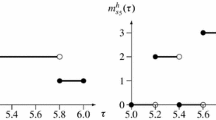Abstract
This study demonstrates the possibility that chaotic fluctuations may be preferable to acompetitive equilibrium. For this purpose, we use a linear cobweb model augmented by thelower and upper bounds for variations of output and construct densities of ergodically chaoticfluctuations. We demonstrate with the aid of numerical examples that the long‐run averageprofit and utility obtained in perpetual disequilibrium can be greater than the profit andutility at equilibrium.
Similar content being viewed by others
References
A. Boyarsky and M. Scarowsky, On a class of transformations which have unique absolutely continuous invariant measure, Transactions of the American Mathematical Society 255(1979)243-261.
A. Boyarsky and G. Haddad, All invariant densities of piecewise linear Markov maps are piecewise constant, Advances in Applied Mathematics 2(1981)284-289.
C. Chiarella, The cobweb model. Its instability and the onset of chaos, Economic Modeling 5(1988)377-384.
F. Cugno and L. Montrucchio, Some new techniques for modeling nonlinear economic fluctuations: A brief survey, in: Nonlinear Models of Fluctuating Growth, eds. R.M. Goodwin, M. Krüger and A. Vercelli, LNEM 228, Springer, Berlin, 1980, pp. 146-165.
R. Day, Cobweb model with explicit suboptimization, in: Modeling Economic Change: The Recursive Programming Approach, eds. R. Day and A. Cigno, North-Holland, Amsterdam, 1980, pp. 191-215.
R. Day, Complex Economic Dynamics, MIT Press, 191994.
C. Hommes, Dynamics of the cobweb model with adaptive expectations and nonlinear supply and demand, Journal of Economic Behavior and Organization 24(1994)315-335.
W. Huang, Caution implies profit, Journal of Economic Behavior and Organization 27(1995)257-277.
S. Ito, S. Tanaka and H. Nakada, On unimodal linear transformation and chaos II, Tokyo Journal of Mathematics 2(1979)241-259.
Jensen and Urban, Chaotic price behavior in a nonlinear cobweb model, Economic Letters 15(1984)235-240.
Lasota and Yorke, On the existence of invariant measures for piecewise monotonic transformations, Transactions of the American Mathematical Society 186(1973)481-488.
A. Matsumoto, Ergodic cobweb chaos, Discrete Dynamics in Nature and Society 1(1997)135-146.
H. Nusse and C. Hommes, Resolution of chaos with application to a modified Samuelson model, Journal of Economic Dynamics and Control 14(1990)1-19.
Z. Artstein, Irregular cobweb dynamics, Economic Letters 11(1983)15-17.
Rights and permissions
About this article
Cite this article
Matsumoto, A. Preferable disequilibrium in a nonlinearcobweb economy. Annals of Operations Research 89, 101–123 (1999). https://doi.org/10.1023/A:1018963204380
Issue Date:
DOI: https://doi.org/10.1023/A:1018963204380




